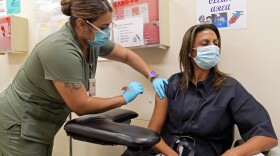A routine meeting of the Washington State Board of Health on Wednesday became the topic of a nationwide misinformation campaign this week as social media users, political hopefuls and conservative pundits spun bogus claims that the meeting would include a vote to force unvaccinated residents into COVID-19 quarantine camps.
A communication manager for the board said it had been inundated with more than 30,000 public comments, some threatening, related to the false theory, which misrepresented the board's scheduled discussion on HIV as a proposed change to COVID-19 policy.
The claims erupted across social media, where widely circulating posts spawned fears of COVID-19 “internment camps," and activists rallied their followers to attend a protest at the Board of Health in Tumwater during the online meeting Wednesday.
Even after the board clarified the facts on its website on Friday, the false notion that the state was plotting to hunt down and detain the unvaccinated persisted across social media platforms, on conservative talk shows and throughout the public comment period of the meeting on Wednesday.
Here's a closer look at the facts.
CLAIM: The Washington State Board of Health at a Jan. 12 public meeting was scheduled to consider a proposed rule change to allow the involuntary detainment of unvaccinated residents in COVID-19 quarantine camps.
THE FACTS: This false claim completely misrepresents the state Board of Health’s scheduled Wednesday discussion on proposed Washington Administrative Code changes, according to Keith Grellner, who chairs the board.
“What we’re doing on Wednesday with the communicable disease rule really doesn’t have anything to do with COVID-19,” Grellner told The Associated Press in a phone interview on Monday. “It has everything to do with implementing a change to the code for HIV that the Legislature mandated we do last year.”
Whenever lawmakers in Washington state pass new bills into law, state agencies codify those laws by creating rules and regulations in the Washington Administrative Code. The code has had a section on communicable and certain other diseases since at least 1988, Grellner said, and it gets amended if lawmakers pass legislation that affects it.
In June 2020, state lawmakers passed a bill “ending statutory HIV/AIDS exceptionalism, reducing HIV-related stigma, defelonizing HIV exposure, and removing barriers to HIV testing,” according to the state Board of Health website. As a result, the board must adjust the Washington Administrative Code to ensure its rules align with the new law.
The section the board has proposed adjusting, WAC 246-100, governs the state’s handling of communicable and certain other infectious diseases. COVID-19, as a communicable disease, falls under that category, but the changes that are currently being proposed do not alter the state’s handling of the disease, Grellner said.
WAC 246-100-040 is a subsection of the code that deals specifically with quarantine and isolation procedures. It has existed since 2003. Social media users claimed the state Board of Health was proposing a change to that section, but both the Board of Health and the code reviser’s office, which governs the Washington Administrative Code, confirmed to the AP that this section has no proposed changes and has not been altered since it was first introduced.
The Washington State Senate's Republican caucus also tweeted a document fact-checking the false claims.
Grellner said he believes the state has only used its quarantine and isolation procedures with regard to tuberculosis, and rarely at that. He added that the procedures don’t give health officials “unilateral” authority to take someone against their will — individuals affected would have the right to petition a superior court for release.
Many states have long had laws in place giving health officers varying degrees of authority to require someone to quarantine or isolate, according to the National Conference of State Legislatures.
Some social media users falsely claimed that the state Board of Health’s meeting Wednesday would also include a vote to require the COVID-19 vaccine for school-aged children. That’s not true, according to the state Board of Health. The board clarified on its website that it would receive a briefing from an advisory group on the topic at the meeting, but it wouldn’t take any action on the matter on Wednesday.
Other posts revived the months-old misleading claim that Washington Gov. Jay Inslee’s office is hiring a “strike team” to run camps where unvaccinated residents could be forced to quarantine.
That claim stems from a real job posting, but not for positions forcing residents to quarantine. Instead, the job postings dealt with a facility in Centralia where visitors to the state could safely quarantine if they did not have another safe place to go.
Mike Faulk, a press secretary for Inslee, confirmed in an email to the AP that the governor has never considered hiring teams to hunt down unvaccinated people or force them to quarantine.
This is part of AP’s effort to address widely shared misinformation, including work with outside companies and organizations to add factual context to misleading content that is circulating online. Learn more about fact-checking at AP.






